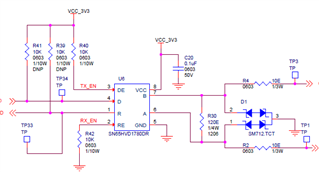Other Parts Discussed in Thread: THVD1406
Hi Team,
We are using SN65HVD1780 part in our design. Refer to the circuit below.
1. DE and RE are always enabled and are not controlled by MCU. Will there be any issue in transmitting and receiving half duplex communication?

2. If there is any concern, drop in replacement to full duplex parts are available? without design change?
Please revert.
Thanks,
Vidhya



